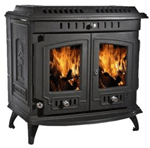
Over the last few years people have realised what many designers have known for some time, that the systematic removal of the fireplace from living rooms in period properties over the last few decades was in fact a terrible mistake.
When central heating became popular in the 1950s the need for a focal fireplace was seemingly eradicated. And because of this the fireplaces which adorned the living rooms across the country were taken out and either plastered over or used instead as a decorative feature in the room. Things have changed however and these long-redundant spaces are being brought back to life with a variety of different heating options.
Cast iron stoves
One of the most popular types of fire nowadays is the cast iron stove. Either in its traditional wood burning variety or its latest multi-fuel incarnation, a cast iron stove isn't just a source of heat it's also a beautiful decorative element which is sure to lift any room in which one is installed.
Contemporary wood burning stoves rely on the pressure variation caused by a traditional chimney to create the natural draught or flue required to remove potentially hazardous fumes created by the burning of wood. And because of the potentially lethal carbon monoxide produced by this type of stove it's essential that it is fitted by a qualified engineer and a suitable carbon monoxide alarm also installed.
In a basic chimney installation the flue pipe from a wood burning stove can sometimes be connected straight to the chimney without the installation of a comprehensive flue system. To do this the flue connector on the stove fits into the chimney and a register plate is fitted to the inside of the chimney to block off the chimney so that a good draw is achieved. The connections are sealed with fire-proof cement to get an air tight fit. A smoke test will generally be done by the installation engineer to make sure that the chimney is drawing correctly and to check for leaks in the system.
Where possible a flue liner should be pulled through any older chimneys to get the most from the system. The flue will improve draw, reduce the risk of a chimney fire and will reduce condensation on the chimney walls due to temperature differences. A reduction in the condensation created can also reduce the build up of tar.
If you don't have a traditional chimney most stoves can be connected to a twin lined stainless flue system which can be installed above the chimney and direct all the fumes out of your home.
Article written by Gary Frost who recommends www.gings.ie for home heating services.
